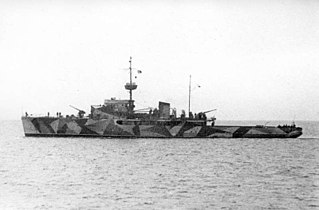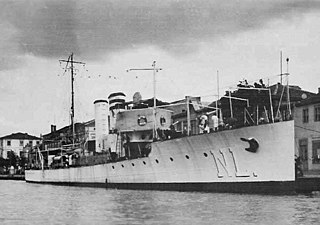
The Romanian Navy is the navy branch of the Romanian Armed Forces; it operates in the Black Sea and on the Danube. It traces its history back to 1860.

The Vifor class was a group of four destroyers ordered by Romania in 1913 and built in Italy during the First World War. The four ships were however requisitioned by Italy in 1915 and rearmed as scout cruisers (esploratori), subsequently seeing service in World War I. Two were re-purchased by Romania in 1920 and saw service in World War II. The other two were eventually transferred by Italy to the Spanish Nationalists and saw service during the Spanish Civil War.

The Regele Ferdinand class was a pair of destroyers built in Italy for the Romanian Navy during the late 1920s. The sister ships were the most modern and powerful warships of the Axis powers in the Black Sea during World War II. During the war they participated in the 1941 Raid on Constanța and the 1944 evacuation of the Crimea, although they spent the vast majority of the war escorting convoys in the Black Sea. The Romanians claimed that they sank two submarines during the war, but Soviet records do not confirm their claims. Following King Michael's Coup, where Romania switched sides and joined the Allies in late 1944, the two ships were seized and incorporated into the Soviet Black Sea Fleet. They were returned to Romania in 1951 and served until 1961 when they were scrapped.

NMS Delfinul was a Romanian submarine that served in the Black Sea during the Second World War. It was the first submarine of the Romanian Navy, built in Italy under Romanian supervision.

The CB class was a group of midget submarines built for the Italian Navy during World War II. However, they were also used by several other navies, seeing action in the Mediterranean and in the Black Sea.

NMS Amiral Murgescu was a minelayer and convoy escort of the Romanian Navy, the first sea-going warship built in Romania and the largest Romanian-built warship of World War II. She laid numerous minefields, from the Bulgarian port of Burgas to the Crimean port of Sevastopol, which inflicted significant losses to the Soviet Black Sea Fleet. She also carried out numerous convoy escort missions and took part in the Axis evacuation of the Crimea in May 1944. Due to her success in combat, she was decorated twice by May 1944. She was captured by the Soviet Union in September 1944 and served until 1988, when she was scrapped.

NMS Marsuinul was a submarine of the Romanian Navy, one of the few warships built in Romania during the Second World War. She was the largest Romanian-built submarine and the most powerful and modern Axis submarine in the Black Sea.
The Romanian Navy during World War II was the main Axis naval force in the Black Sea campaigns and fought against the Soviet Union's Black Sea Fleet from 1941 to 1944. Operations consisted mainly of mine warfare, but there were also escort missions and localized naval engagements. The largest naval action fought by the Romanian Navy was the 26 June 1941 Raid on Constanța, and its most extensive operation was the 1944 evacuation of the Crimea.

NMS Mărăști was one of four Vifor-class destroyers ordered by Romania shortly before the beginning of the First World War from Italy. All four sister ships were requisitioned when Italy joined the war in 1915. Originally named Vijelie by the Romanians, she was renamed Sparviero in Italian service. Not completed until mid-1917, the ship engaged Austro-Hungarian ships in the Adriatic Sea only twice before the war ended in November 1918. She was given a new name as Mărăști when she was re-purchased by the Romanians in 1920.

NMS Mărășești was one of four Vifor-class destroyers ordered by Romania shortly before the beginning of the First World War from Italy. All four sister ships were requisitioned when Italy joined the war in 1915. Originally named Vârtej by the Romanians, she was renamed Nibbio in Italian service. Not completed until mid-1918, the ship engaged Austro-Hungarian ships in the Adriatic Sea only once before the war ended in November. She was renamed Mărășești when she was re-purchased by the Romanians in 1920.

NMS Constanța was a submarine tender of the Romanian Navy. She was commissioned in 1931 and fought in the Second World War, being scrapped in 1977.

NMS Sublocotenent Ghiculescu was a specialized ASW gunboat of the Romanian Navy. Initially built as a French warship in late World War I, she was purchased by Romania in 1920 and fought during World War II, sinking two submarines and one motor torpedo boat. After 1 year of Soviet service, she was returned to Romania and served as a survey vessel until 2002.

NMS Năluca was a torpedo boat of the Royal Romanian Navy. She was commissioned in 1920, after initially serving as Tb 82 F in the Austro-Hungarian Navy during World War I. She and six more sister ships were awarded to Romania as reparations after the war ended.

NMS Rechinul was a submarine of the Romanian Navy, one of the few warships built in Romania during World War II and used during the war. She was made at the Galați shipyard in 1938, launched in 1941, and completed in 1942. Rechinul took part in the evacuation of the Crimea and later performed the longest mission in Romanian submarine history, starting on 15 June 1944 and lasting 45 days.

Moskva was one of six Leningrad-class destroyer leaders built for the Soviet Navy during the 1930s, one of the three Project 1 variants. Completed in 1938 and assigned to the Black Sea Fleet, she participated in the Raid on Constanța on 26 June 1941, a few days after the beginning of the German invasion of the Soviet Union. After the ship had finished bombarding targets in the port, she was sunk by a mine.

NMS Regele Ferdinand was the lead ship of her class of two destroyers built in Italy for the Romanian Navy in the late 1920s. After the Axis invasion of the Soviet Union on 22 June 1941, she was limited to escort duties in the western half of the Black Sea during the war by the powerful Soviet Black Sea Fleet which heavily outnumbered Axis naval forces in the Black Sea. The ship may have sunk two Soviet submarines during the war. In early 1944 the Soviets were able to cut off and surround the port of Sevastopol on the Crimean Peninsula. Regele Ferdinand covered convoys evacuating Axis troops from Sevastopol and was badly damaged in May when she rescued some troops herself.

NMS Regina Maria was the second and last of the two Regele Ferdinand-class destroyers built in Italy for the Romanian Navy in the late 1920s. After the Axis invasion of the Soviet Union on 22 June 1941, she took part in the Raid on Constanța a few days later and may have damaged a Soviet destroyer leader during the battle. The powerful Soviet Black Sea Fleet heavily outnumbered Axis naval forces in the Black Sea and the Romanian destroyers were limited to escort duties in the western half of the Black Sea during the war. In early 1944 the Soviets were able to cut off and surround the port of Sevastopol on the Crimean Peninsula. Regina Maria covered convoys evacuating Axis troops from Sevastopol in May and rescued several hundred herself.

NMS Regele Carol I was a passenger ship of the Romanian Maritime Service and later a warship of the Romanian Navy, serving as both minelayer and seaplane tender. She was completed and commissioned in 1898 and sunk in 1941, during World War II.
Smely was one of 18 Storozhevoy-class destroyers built for the Soviet Navy during the late 1930s. Although she began construction as a Project 7 Gnevny-class destroyer, Smely was completed in 1941 to the modified Project 7U design.




















